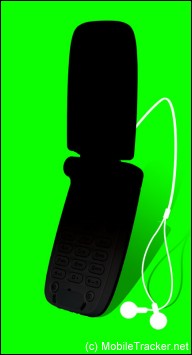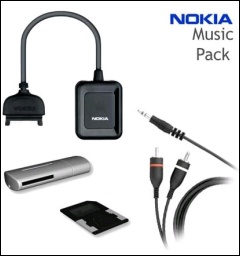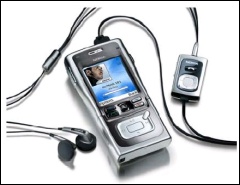 Mobile Music
Mobile Music
Going into 2006 there seems to be one overriding message from the carriers and the handset manufacturers. Music on mobile phones will be our saviour. With this, revenue will flow, everyone will jump to buy a new stereo MP3-capable handset, and the world will be right again.
Part of me doesn’t think that this picture is ever going to happen. Mobile Music might be popular, but Music on Mobiles is far from proving itself.
Who Wants It?
You’ll note that this is the industry telling you that you’ll be using this brand new feature. Now their track record in ‘the next big thing’ hasn’t been all that great. WAP, while now tweaked towards XML browsers, never became the Mobile Internet. And neither did MMS become the great revenue it was going to be when everyone switched from SMS (10p a message) to MMS (in those days 40p a message). Of the two big changes in mobile technology, SMS just exploded and happened with little push from the networks, although putting cameras in the phones (part of the MMS story) has been justified to the point where they are now in most instances a commodity that has to be there.
Nokia will be quick to point out that they are one of the biggest digital camera manufacturers, if not the largest, all built on the number of phones that now carry cameras. And I’m sure at some point in 2006, Nokia will overtake Apple as the biggest MP3/Digital Audio Players manufacturer on the planet, overtaking the iPod’s total of 45 million units.
Just remember that Nokia are counting any phone that can ‘play back MP3 files in stereo’ as an MP3 phone, and with their Stereo Headset Adapter, they already have tens of millions of them. But who’s listening?
Who indeed? A straw poll around some All About Symbian readers and staff show that out of 20 power users of Symbian OS, while we all have a number of MP3 files for ring tones and alarms, only four of us are using a smartphone to listen to multimedia. Even then one of those is an N-Gage classic user that relies on the FM Radio to get the evening news.
Is music where the convergence argument breaks down? I think so. The problem with convergence on a mobile device is brought sharply into focus with music handsets. First of all, ergonomics. We’ve come a long way from the cassette walkman, which had stop, play, forward and rewind. We expect to have a way to jump albums and playlists, to scan forward and back. We want to see some album artwork and notes embedded in the music file.
Now you could use the keypad numbers, but that’s not going to cut it in a mass market device – and believe me these music phones, with gigs of memory, are aimed squarely at mass market, so geeky workaround will not cut it. The problem of course is that some of the best controls are on the Apple iPod, and nobody’s got a cat's chance of licensing that design in the near future. Nokia have two solutions; on the N91, the phone controls are slid away, and the 3250 has a rotating section which has numbers on one side and playback controls on the other. It remains to be seen what these are like in practice, and more to the point in someone’s pocket, which is where these phones are going to live. The other major factor in any music device is how you listen to the sound, and that means giving the user a choice about headphones. Modern devices are starting to come with a 3.5mm stereo headphone socket, which is a must. Having to buy a clip on device (as in the Nokia Pop Port music adapter) might help your ‘MP3 units sold” but it does nothing for the user experience. I think it’s vital that the 3.5mm socket is available over the entire range of phones that are marked as music phones.
It remains to be seen what these are like in practice, and more to the point in someone’s pocket, which is where these phones are going to live. The other major factor in any music device is how you listen to the sound, and that means giving the user a choice about headphones. Modern devices are starting to come with a 3.5mm stereo headphone socket, which is a must. Having to buy a clip on device (as in the Nokia Pop Port music adapter) might help your ‘MP3 units sold” but it does nothing for the user experience. I think it’s vital that the 3.5mm socket is available over the entire range of phones that are marked as music phones.
The last of the big three notes is always my biggest worry – battery life. Mobile phones are having more and more demands placed on their power, and making sure that a device lasts a business day and a bit more is a basic design rule of thumb. Unfortunately pushing out audio really hits the battery on current devices, if you're planning on tripping out for more than a couple of hours, and I don’t see a huge change being made in battery technology in the next few months. You’re always going to have one eye on that battery gauge when you’ve got your music playing, because you just might have to make a five-minute call near the end of the day.
Getting The Music
And then of course, there is "how do you get the music on to your phone?". Now, if the world was a simple, fair and balanced place, then it would be a simple matter of taking your CD (or cassette, or 8-track), ripping the sounds to MP3 (or Ogg Vorbis or WMA, if you’re Steve) and copying the files to your phone. You know it’s not going to be that easy. Currently Nokia’s Music Manager is functional at best, but it’s never going to win any prizes. Last year’s 3GSM saw Nokia license the technology to use Windows Media Player (and Plays For Sure) and that includes a “sync device option” which has a lot of quirks, but at least it’s something approaching a standard. For now, using an MMC/SD reader on your PC is probably the easiest option, but work is definitely needed.
The networks have another solution for you, though. Just buy the music again from us. Sure, you’ve already got The Beatles White Album, but now you can order a low bitrate copy from us, use your monthly bandwidth to grab the track from our servers, and you can listen to it on your phone. Oh you want to back it up on your PC… ehrm… we’re not sure about that yet. Just download it again if you ever lose it or want it on another phone, okay?
Another option is the subscription stores such as Napster, which for $15 a month allow you to ‘borrow’ music to install (via a DRM mechanism) to a Plays For Sure device. This will probably be the best route to go down if you’re going for a Network branded solution, as these are sure to pop up. Besides, using the PC for the download will ease the strain on the GSM/GPRS networks.
 Will It Succeed?
Will It Succeed?
Let’s make no bones about it, the industry has spoken. At the end of 2006 the figures will show that Nokia are larger than Apple for digital audio players, that the digital music downloads industry received a massive boost thanks to the mobile phone, and that there is a massive “adoption” of music phones in the market. Will it be good for the consumer though? There’s no doubt that some people will welcome convergence, and a straightforward solution to music on mobiles would be welcomed by many.
Right now, though, there are too many hoops to jump through, and massive pitfalls lie in wait for consumers. If people are getting angry when they can’t move a ten second ringtone between their phones, how are they going to cope when the latest 15 track album is DRM-locked to their phone? Interesting times, and a lot of challenges await the industry.
Second opinion (Steve Litchfield): Some good points, Ewan. Yes, DRM-heavy over-the-air downloads are going to be an unnecessary pain. Yes, PC syncing of music needs sorting out once and for all. Yes, battery life needs to be considered if you're planning on playing a lot of music (i.e. all day). But smartphones will increasingly come with dedicated music controls; even most Nokia devices of today have music control via the standby screen.
One final point, where I disagree, is that there's little point in going for a 3.5mm stereo jack standard on a smartphone. A traditional headset won't let you answer a call, for a start. Most popular smartphones of today ship with either a 4-way 2.5mm connector or a proprietary (Pop port) headset. Aren't these popular enough to be standards in their own right? And unless you're planning to spend the best part of £100 on a deluxe noise-cancelling set of headphones, you're not going to hear the difference between a hi-fi set and your 'free' set that came with the smartphone. Not while you're rattling around on a bus or train or walking along the high street.
What are everyone else's thoughts?
